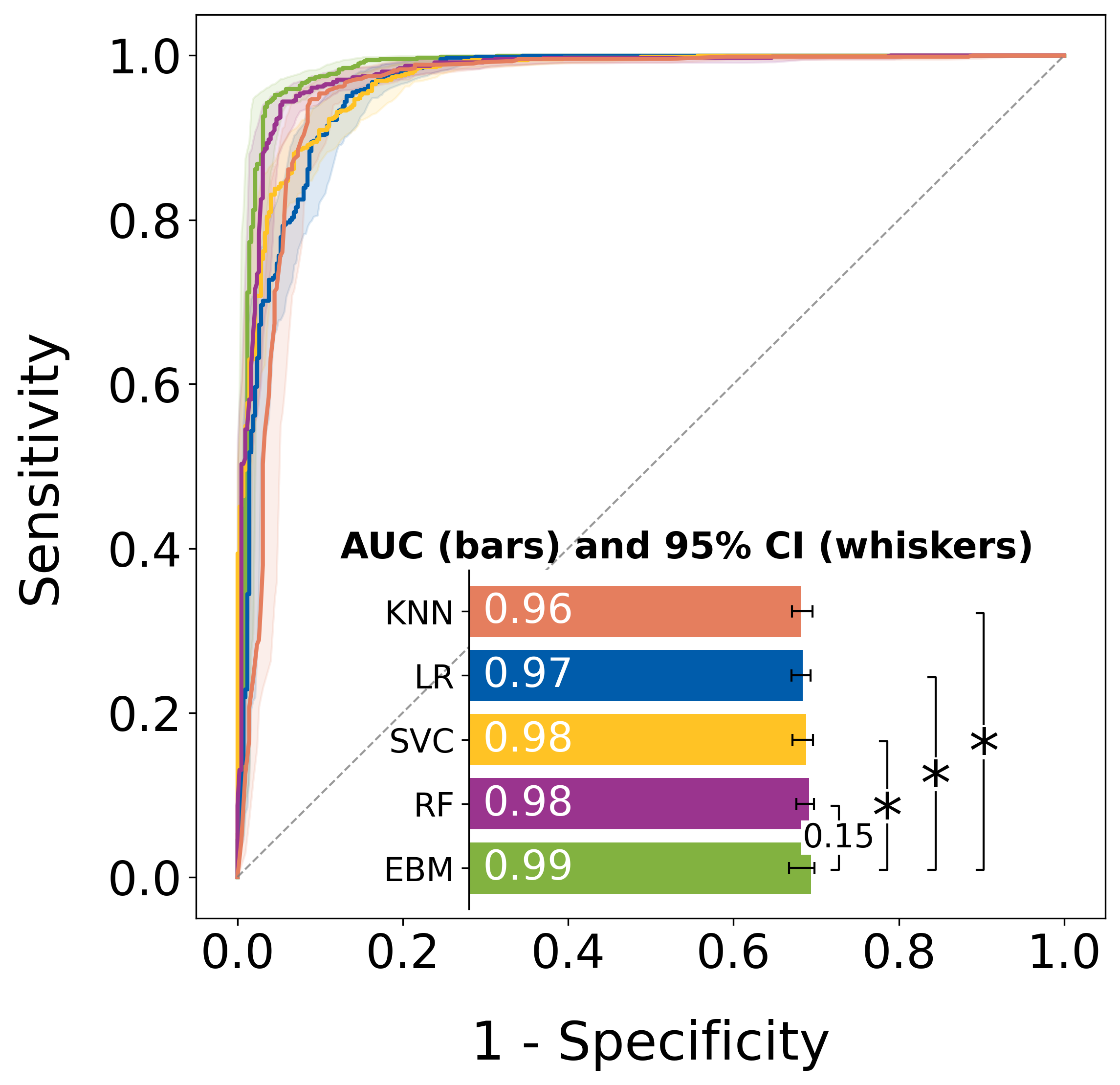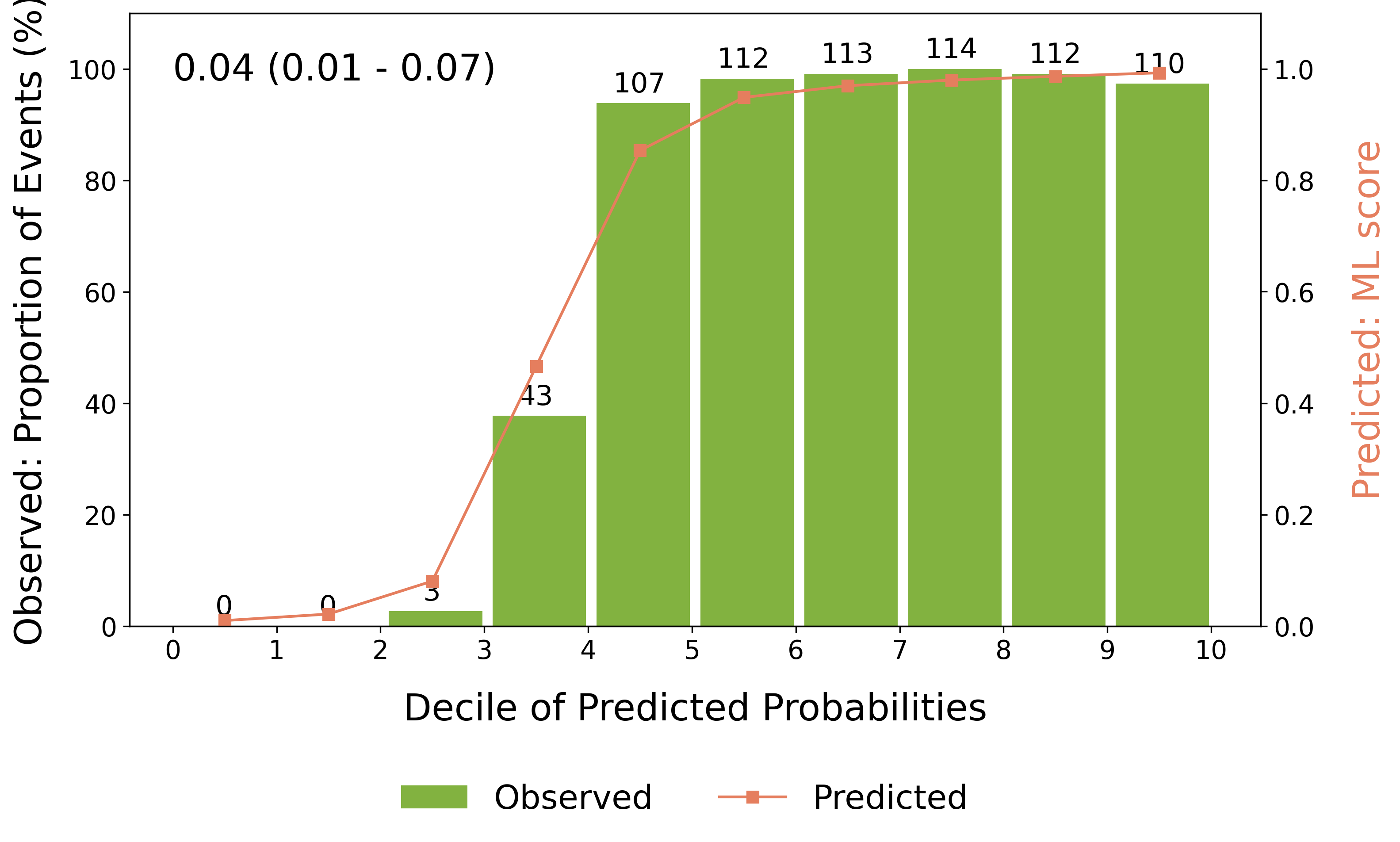Better insights into Machine Learning models performance
Project description

Welcome to modelsight
Better insights into Machine Learning models performance.
Modelsight is a collection of functions that create publication-ready graphics for the visual evaluation of cross-validated binary classifiers adhering to the scikit-learn interface.
While the majority of modelsight functionalities are compatible with any binary classifier that follows scikit-learn's interface, it's worth noting that, as of now, some features are exclusive to ExplainableBoostingClassifier from the interpretml package.
| Overview | |
|---|---|
| Open Source |  |
| CI/CD |    |
| Code |   |
💫 Features
Our objective is to enhance the visual assessment of cross-validated binary classifiers by introducing a set of functions tailored for generating publication-ready plots.
To effectively utilize modelsight, you should provide a dictionary where the keys represent model names, and the values consist of CVModellingOutput objects. CVModellingOutput is a custom data class designed to encapsulate the results of a cross-validation process for a specific binary classifier. For detailed information about CVModellingOutput, please refer to the API reference.
Before using the functionalities offered by this library, ensure that your cross-validation data adheres to this structure.
| Module | Status | Links |
|---|---|---|
| Calibration | maturing | Tutorial · API Reference |
| Curves | maturing | Tutorial · API Reference |
:eyeglasses: Install modelsight
- Operating system: macOS X · Linux
- Python version: 3.10 (only 64-bit)
- Package managers: pip
pip
Using pip, modelsight releases are available as source packages and binary wheels. You can see all available wheels here.
$ pip install modelsight
:zap: Quickstart
The following code will cross-validate five different binary classifiers and produce a dictionary of CVModellingOutput.
import numpy as np
import pandas as pd
import matplotlib.pyplot as plt
from sklearn.datasets import load_breast_cancer
from sklearn.model_selection import train_test_split
from sklearn.model_selection import StratifiedKFold, RepeatedStratifiedKFold
from sklearn.metrics import roc_curve
from sklearn.svm import SVC
from sklearn.ensemble import RandomForestClassifier
from sklearn.neighbors import KNeighborsClassifier
from sklearn.linear_model import LogisticRegression
from interpret.glassbox import ExplainableBoostingClassifier
from tests.utils import (
select_features,
get_feature_selector,
get_calibrated_model
)
from modelsight._typing import CVModellingOutput, Estimator
# Load data
X, y = load_breast_cancer(return_X_y=True, as_frame=True)
# Define factory for binary classifiers
class BinaryModelFactory:
def get_model(self, model_name: str) -> Estimator:
if model_name == "EBM":
return ExplainableBoostingClassifier(random_state=cv_config.get("SEED"),
interactions=6,
learning_rate=0.02,
min_samples_leaf=5,
n_jobs=-1)
elif model_name == "LR":
return LogisticRegression(penalty="elasticnet",
solver="saga",
l1_ratio=0.3,
max_iter=10000,
random_state=cv_config.get("SEED"))
elif model_name == "SVC":
return SVC(probability=True,
class_weight="balanced",
random_state=cv_config.get("SEED"))
elif model_name == "RF":
return RandomForestClassifier(random_state=cv_config.get("SEED"),
n_estimators=5,
max_depth=3,
n_jobs=-1)
elif model_name == "KNN":
return KNeighborsClassifier(n_jobs=-1)
else:
raise ValueError(f"{model_name} is not a valid estimator name.")
cv_config = {
"N_REPEATS": 2,
"N_SPLITS": 10,
"SHUFFLE": True,
"SCALE": False,
"CALIBRATE": True,
"CALIB_FRACTION": 0.15,
"SEED": 1303
}
# define outer and inner cross-validation schemes
outer_cv = RepeatedStratifiedKFold(n_repeats=cv_config.get("N_REPEATS"),
n_splits=cv_config.get("N_SPLITS"),
random_state=cv_config.get("SEED"))
inner_cv = StratifiedKFold(n_splits=cv_config.get("N_SPLITS"),
shuffle=cv_config.get("SHUFFLE"),
random_state=cv_config.get("SEED"))
# define models names, factory and cv results dictionary
models_names = ["EBM", "LR", "SVC", "RF", "KNN"]
model_factory = BinaryModelFactory()
cv_results = dict()
for model_name in models_names:
print(f"Processing model {model_name}\n")
gts_train = []
gts_val = []
probas_train = []
probas_val = []
gts_train_conc = []
gts_val_conc = []
probas_train_conc = []
probas_val_conc = []
models = []
errors = []
correct = []
features = []
for i, (train_idx, val_idx) in enumerate(outer_cv.split(X, y)):
Xtemp, ytemp = X.iloc[train_idx, :], y.iloc[train_idx]
Xval, yval = X.iloc[val_idx, :], y.iloc[val_idx]
if cv_config.get("CALIBRATE"):
Xtrain, Xcal, ytrain, ycal = train_test_split(Xtemp, ytemp,
test_size=cv_config.get(
"CALIB_FRACTION"),
stratify=ytemp,
random_state=cv_config.get("SEED"))
else:
Xtrain, ytrain = Xtemp, ytemp
model = model_factory.get_model(model_name)
# select features
feat_subset = select_features(Xtrain, ytrain,
selector=get_feature_selector(
cv_config.get("SEED")),
cv=inner_cv,
scale=False,
frac=1.25)
features.append(feat_subset)
if cv_config.get("SCALE"):
numeric_cols = Xtrain.select_dtypes(
include=[np.float64, np.int64]).columns.tolist()
scaler = StandardScaler()
Xtrain.loc[:, numeric_cols] = scaler.fit_transform(
Xtrain.loc[:, numeric_cols])
Xtest.loc[:, numeric_cols] = scaler.transform(
Xtest.loc[:, numeric_cols])
model.fit(Xtrain.loc[:, feat_subset], ytrain)
if cv_config.get("CALIBRATE"):
model = get_calibrated_model(model,
X=Xcal.loc[:, feat_subset],
y=ycal)
models.append(model)
# accumulate ground-truths
gts_train.append(ytrain)
gts_val.append(yval)
# accumulate predictions
train_pred_probas = model.predict_proba(Xtrain.loc[:, feat_subset])[:, 1]
val_pred_probas = model.predict_proba(Xval.loc[:, feat_subset])[:, 1]
probas_train.append(train_pred_probas)
probas_val.append(val_pred_probas)
# identify correct and erroneous predictions according to the
# classification cut-off that maximizes the Youden's J index
fpr, tpr, thresholds = roc_curve(ytrain, train_pred_probas)
idx = np.argmax(tpr - fpr)
youden = thresholds[idx]
labels_val = np.where(val_pred_probas >= youden, 1, 0)
# indexes of validation instances misclassified by the model
error_idxs = Xval[(yval != labels_val)].index
errors.append(error_idxs)
# indexes of correct predictions
correct.append(Xval[(yval == labels_val)].index)
# CV results for current model
curr_est_results = CVModellingOutput(
gts_train=gts_train,
gts_val=gts_val,
probas_train=probas_train,
probas_val=probas_val,
gts_train_conc=np.concatenate(gts_train),
gts_val_conc=np.concatenate(gts_val),
probas_train_conc=np.concatenate(probas_train),
probas_val_conc=np.concatenate(probas_val),
models=models,
errors=errors,
correct=correct,
features=features
)
cv_results[model_name] = curr_est_results
Plot the average receiver-operating characteristic (ROC) curves
from modelsight.curves import (
average_roc_curves,
roc_comparisons,
add_annotations
)
model_names = list(cv_results.keys())
alpha = 0.05
alph_str = str(alpha).split(".")[1]
alpha_formatted = f".{alph_str}"
roc_symbol = "*"
palette = [Colors.green2, Colors.blue, Colors.yellow, Colors.violet, Colors.darksalmon]
n_boot = 100
f, ax = plt.subplots(1, 1, figsize=(8, 8))
kwargs = dict()
f, ax, barplot, bars, all_data = average_roc_curves(cv_results,
colors=palette,
model_keys=model_names,
show_ci=True,
n_boot=n_boot,
bars_pos=[
0.3, 0.01, 0.6, 0.075*len(model_names)],
random_state=cv_config.get("SEED"),
ax=ax,
**kwargs)
roc_comparisons_results = roc_comparisons(cv_results, "EBM")
kwargs = dict(space_between_whiskers = 0.07)
order = [
("EBM", "RF"),
("EBM", "SVC"),
("EBM", "LR"),
("EBM", "KNN")
]
ax_annot = add_annotations(roc_comparisons_results,
alpha = 0.05,
bars=bars,
direction = "vertical",
order = order,
symbol = roc_symbol,
symbol_fontsize = 30,
voffset = -0.05,
ext_voffset=0,
ext_hoffset=0,
ax=barplot,
**kwargs)
This produces the following plot:

Assess calibration of the ExplaianbleBoostingClassifier across
We will now compute median Brier score (95% CI) of the ExplainableBoostingClassifier and use it to annotate the calibration plot.
from sklearn.metrics import brier_score_loss
from modelsight.calibration import hosmer_lemeshow_plot
briers = []
for gt, preds in zip(cv_results["EBM"].gts_val, cv_results["EBM"].probas_val):
brier = brier_score_loss(gt, preds)
briers.append(brier)
brier_low, brier_med, brier_up = np.percentile(briers, [2.5, 50, 97.5])
brier_annot = f"{brier_med:.2f} ({brier_low:.2f} - {brier_up:.2f})"
f, ax = plt.subplots(1, 1, figsize=(11,6))
f, ax = hosmer_lemeshow_plot(cv_results["EBM"].gts_val_conc,
cv_results["EBM"].probas_val_conc,
n_bins=10,
colors=(Colors.darksalmon, Colors.green2),
annotate_bars=True,
title="",
brier_score_annot=brier_annot,
ax=ax
)
This produces the following plot:

:gift_heart: Contributing
Interested in contributing? Check out the contributing guidelines. Please note that this project is released with a Code of Conduct. By contributing to this project, you agree to abide by its terms.
🛣️ Roadmap
Features:
- Calibration module to assess calibration of ML predicted probabilities via Hosmer-Lemeshow plot
- Average Receiver-operating characteristic curves
- Average Precision-recall curves
- Feature importance (Global explanation)
- Individualized explanations (Local explanation)
Project details
Release history Release notifications | RSS feed
Download files
Download the file for your platform. If you're not sure which to choose, learn more about installing packages.
Source Distribution
Built Distribution
Hashes for modelsight-0.4.0-py3-none-any.whl
| Algorithm | Hash digest | |
|---|---|---|
| SHA256 | 9fe534f0f5cca40d98c5ae6970b0d7f59f470494e12d21ff813dd6459dbe3d61 |
|
| MD5 | 14f08a2b08a084b746fd2f72cb70718e |
|
| BLAKE2b-256 | e6d9c2e502e8b6b64c860d078b5ae9391f199d3bc3e53f30eba01ded56e655b3 |











